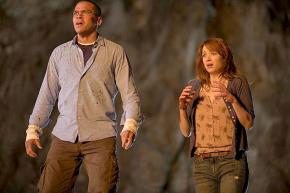Saving horror from itself
reviews the latest film from Buffy the Vampire Slayer creator Joss Whedon--and looks at what it has to say about the genre of horror itself.
JOSS WHEDON (Buffy the Vampire Slayer) and Drew Goddard (Cloverfield) have produced one of the best horror movies in years. In light of that fact, this review will attempt to support its arguments without revealing any major "spoilers," or at least nothing you wouldn't know from watching the trailer.
Over the past decade, the horror genre has begun to devour itself, like some self-cannibalizing zombie. Mannerism--essentially the reinvention of old films--and gore-for-gore's sake became the touchstones of what once had been one of the most innovative genres in modern cinema.
The almost-always inferior remakes of classic horror films--The Crazies, Texas Chainsaw Massacre, Dawn of the Dead, The Hills Have Eyes--have usually been preferable to the even worse and ultra-reactionary torture franchises like Saw and Eli Roth's Hostel.
The innovative use of "gore" pioneered by George Romero's zombie movies (anchored by his version of humanist despair) or in the first "slasher" films of the 1970s and 1980s (influenced in different ways by the memories of the Vietnam War, coupled with the uncertainties of the post-"American Dream" United States), were replaced by the voyeuristic torture of human beings for torture's sake.

Even the blood-laden Evil Dead series projected a human touch in the classical use of the unlikely hero myth--Ash, who worked at the fictional big box retailer S-Mart--and in its combination of Three Stooges-esque slapstick with gallons of "bodily fluids."
But horror in the 21st century lost its way. The Scream series put a cynical, however funny, self-referential bookend on the slasher movie. Zombieland and the Resident Evil franchise boiled zombie movies down into a set of clichés. Increasingly, fans of horror were left with gore and gore alone.
Watching a new horror movie became, in effect, an invitation to join in virtual serial murder. At best you might hope to find an action movie or formulaic comedy--in the case of Zombieland and Shaun of the Dead, a romantic comedy--with a relatively gruesome setting.
This is not to say there haven't been some very good 21st century horror movies--Teeth, 28 Days Later, Land of the Dead and Zombie Honeymoon are all good examples. However, these were few and far between, and none dealt specifically with the crisis of the genre itself.
That is, until now.
THE CABIN in the Woods is not simply a "Whedonesque" version of Scream--a "winking" deconstruction of the horror genre. It is Drew Goddard and Joss Whedon's attempt to save horror from itself, to re-enchant a genre that has been gutted by the ruthless "rationality"--in pursuit of profits, of course--of the contemporary studio system.
This attempt to rescue the legacy of horror feeds back (and forth) into the plot of the film and its wider meanings.
Five young people--in the archetypal horror movie roles of (as the movie itself describes them) "whore, athlete, scholar, fool and virgin"--head to an isolated rural cabin for a weekend of drinking, drugs, swimming and fun.
In traditional horror films of this sort, these characters are usually punished by the primitive surroundings for their modernity (promiscuity, drug use, pride, etc.). This can take the form of everything from spirits to "redneck zombies" or something more earthly. The theme is echoed in movies as dissimilar as The Hills Have Eyes, Deliverance and, of course, Friday the 13th.
In this particular subgenre, Whedon and Goddard mimic the "last girl standing" plot line familiar to many, but not all, of these films.
The antagonist in The Cabin in the Woods, however, is not primitiveness or the lone "crazy person" rejected by an otherwise healthy society, but the "modern" men and women of some sort of bureaucratic secret facility. These "middle-management" types monitor and manipulate the horrors in the "cabin in the woods" behind from bunker doors. They are, to borrow a phrase, simultaneously banal and evil. They do not see themselves as evil, however.
Moreover, none of the five principal characters actually fits their explicitly defined role. They are manipulated, in various ways, to fit into them.
The filmmakers have rightly tried to keep a blackout on plot spoilers. This limits what can be said in any review, but it does leave this much--that the results of Whedon and Goddard's film are both brilliant and funny.
For example, prophetic ramblings of doom by a toothless gas station attendant are treated as office jokes by the "middle management." Moreover, the filmmakers succeed in beginning to rescue the essential core of the horror genre from itself.
More important still, they connect that cinematic project to the feeling of general disenchantment wrought by the way people experience seemingly arbitrary power in a declining system. Goddard and Whedon have made a Romantic film, in the historical sense, a primal cry against the constraints that surround us (or surround art or cinema).
Fittingly, the bankruptcy of MGM almost killed The Cabin in the Woods. The film sat on the shelf for years. Bureaucrats almost killed a movie that is, in no small part, an attack on the impersonal power of contemporary life. To say more would inevitably "spoil" the film. So I will just wrap up saying, "All power to the old gods!"
You will understand what I mean once you see the hilarious--and, yes, fairly gory--festival-like final act of the film.


